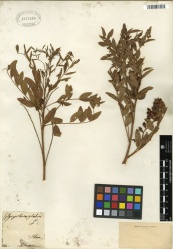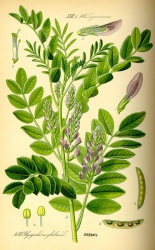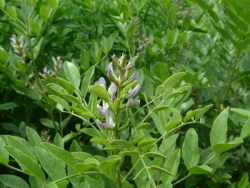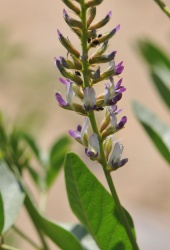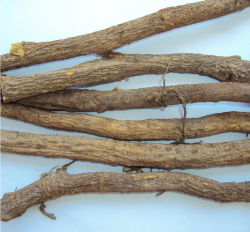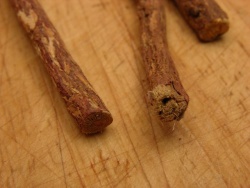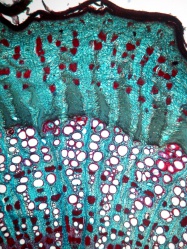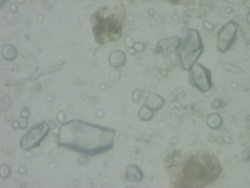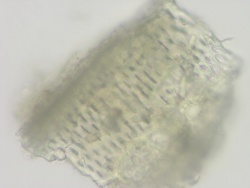Nomenclature
Botanical Voucher Specimen
Organoleptic Characteristics
| Color: Unpeeled – yellowish or purplish brown to dark brown externally and yellowish internally. Peeled – pale yellow.
Source: Natural Remedies Pvt Ltd [2]
|
|
|
|
| Aroma/Odor: Characteristic
Flavor/Taste: Sweet, sugary
Source: American Herbal Products Association. March 2013. Organoleptic Analysis of Herbal Ingredients. AHPA: Silver Spring, MD [3]
|
|
|
|
|
Macroscopic Characteristics
| "...Root nearly cylindrical up to 2 cm in diameter, externally wrinkled with patches of cork. Fracture, coarsely fibrous in bark and splintery in wood."
Source: Natural Remedies Pvt Ltd [4]
|
|
|
|
|
Microscopic Characteristics
| "Rhizome: Transverse section of stolon more or less rounded. Phellem severeal layered with tabular cells; outer layers filled with reddish brown contents, inner colourless. Phellogen indistinct; phelloderm three to five layered, collenchymatous; some of the cells contain calcium oxalate and minute starch grains. Secondary phloem with numerous concentrically arranged bundles of phloem fibres and surrounded by a parenchymatous sheath containing prisms of calcium oxalate. Medullary rays distinct, bi-to multiseriate, parenchymatous, in continuation with those of xylem. The rays are narrower in xylem and wider in phloem region. Xylem consists of vessels, fibres and lignified wood parenchyma. The unpeeled drug shows the presence of polyhedral tubular brownish cork cells. In case of stolons, the pith is present and is parenchymatous. The root is characterized by the presence of tetrarch xylem and absence of pith.
Powder Microscopy: It shows plenty of starch grains, hexagonal crystals vessel elements are with reticulate wall pitting."
Source: Natural Remedies Pvt Ltd [10]
|
|
|
|
|
High Performance Liquid Chromatographic Identification
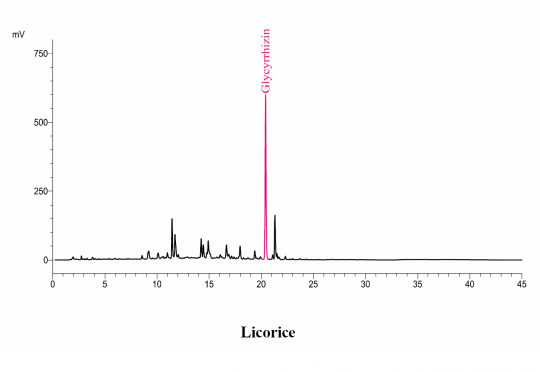
G. glabra reference standard
'Sample Preparations: Extract 1.0 g of coarsely powdered Glycyrrhiza root in 50 mL of water by boiling for about 5 minutes, and filter. Repeat for 4-5 times or until the extract is colorless. Combine the extracts, concentrate to about 100 mL, and cool to room temperature. Before injection, filter through a membrane filter of 0.45-um or finer pore size, discarding the first 5 mL of the filtrate.
Column: C18, 25-cm x 4.6 mm, 5-um, XXXXX, XXXXX
Mobile Phase: 0.14 g of anhydrous potassium dihydrogen phosphate in 900 mL of water, add 0.5 mL phosphoric acid, mix, complete to volume with water, and mix (Solution A); and acetonitrile (Solution B)
Elution: gradient program, see below
Flow rate: 1.5 mL/min
Detection: UV, 254 nm
Injection volume: 20 uL
Source: Natural Remedies Pvt Ltd [14]
High Performance Thin Layer Chromatographic Identification
Supplementary Information
Sources
- ↑ Tropicos.org. Missouri Botanical Garden. 27 Feb 2014 <http://www.tropicos.org/Image/100253567>
- ↑ Natural Remedies Pvt Ltd http://www.naturalremedy.com/
- ↑ American Herbal Products Association. March 2013. Organoleptic Analysis of Herbal Ingredients. AHPA: Silver Spring, MD http://www.ahpa.org/
- ↑ Natural Remedies Pvt Ltd http://www.naturalremedy.com/
- ↑ Flora von Deutschland, Österreich und der Schweiz- Otto Wilhelm Thomé (1885)
- ↑ Encyclopedia of Life http://eol.org/data_objects/2447928
- ↑ Encyclopedia of Life http://eol.org/data_objects/24932881
- ↑ Natural Remedies Pvt Ltd http://www.naturalremedy.com/
- ↑ Encyclopedia of Life http://eol.org/data_objects/19163752
- ↑ Natural Remedies Pvt Ltd http://www.naturalremedy.com/
- ↑ Natural Remedies Pvt Ltd http://www.naturalremedy.com/
- ↑ Natural Remedies Pvt Ltd http://www.naturalremedy.com/
- ↑ Natural Remedies Pvt Ltd http://www.naturalremedy.com/
- ↑ Natural Remedies Pvt Ltd http://www.naturalremedy.com/
